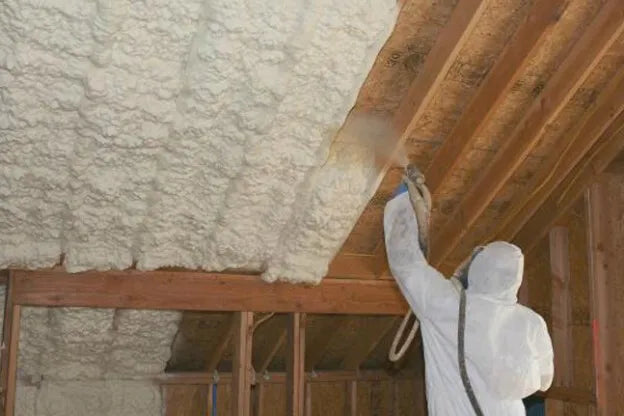Spray foam insulation is popular for homeowners looking to increase their home's energy efficiency and reduce energy costs. However, it's crucial to understand the necessary precautions and wait time before reentering a recently insulated house with spray foam.
Experts recommend waiting approximately 24-48 hours before returning to a spray foam-insulated home. This timeframe allows the foam to fully cure and dry, minimizing the potential off-gassing of chemicals. It's essential to prioritize proper ventilation during this period to aid in removing any lingering fumes or odors.

By following these guidelines, homeowners can ensure a safe reentry into a newly sprayed foam-insulated area and avoid any potential health risks associated with an early return.
Read More: Spray Foam Cost Per Square Foot
Health Considerations and Best Practices for Reentering a Spray Foam Insulated Home
When reentering a spray foam-insulated home, it is crucial to understand the potential health risks associated with early reentry. Freshly sprayed foam-insulated spaces can emit volatile organic compounds (VOCs) and other chemicals that may be harmful if inhaled in high concentrations.
For optimal safety, it is recommended that you wait until the foam has fully cured and any off-gassing has dissipated before returning to the house. The safe reentry time after spray foam insulation typically ranges from 24 to 48 hours, depending on the specific product used. This waiting period allows the foam to settle fully and ensures that any potential risks are minimized.
Read More: Is foam insulation safe for health?
Proper ventilation is key during this time to help remove fumes or odors. Opening windows and utilizing fans can significantly improve air quality and reduce exposure to VOCs. Additionally, wearing protective gear such as gloves and a mask is advisable when working or spending extended periods in a recently sprayed foam-insulated area.
By following these best practices and safety guidelines, homeowners can minimize the health concerns associated with spray foam insulation and ensure a safe reentry into their homes.
Read More: Spray Foam Insulation Explained
Tips for Managing Air Quality and Minimizing Exposure to VOCs
After installing spray foam insulation, it is crucial to prioritize proper ventilation and minimize exposure to volatile organic compounds (VOCs) emitted by the foam. To achieve this, homeowners should implement effective air quality management strategies.
The first step is to ensure proper ventilation. Opening windows and allowing fresh air to circulate will help remove any lingering fumes or odors. Also, using exhaust fans and running air purifiers can help improve air circulation and filter out potentially harmful VOCs.
Read More: Is closed cell foam air permeable?
Regularly monitoring air quality during the initial few days after installation is also essential. This ensures that VOC levels remain within acceptable limits and mitigates any health concerns associated with exposure. Homeowners can consult a professional specializing in indoor air quality or a certified air quality inspector for further guidance and reassurance.
By taking these precautions and proactively managing air quality, homeowners can enjoy the energy-saving benefits of spray foam insulation while minimizing potential health risks.
Read More: Is there a downside to spray foam insulation?
FAQ
How long should I stay out of my house after applying spray foam insulation?
It is recommended that you wait 24-48 hours before reentering a spray foam-insulated home to allow the foam to fully cure and dry.
What are the health risks of early reentry into a freshly sprayed foam-insulated space?
Freshly sprayed foam-insulated spaces may emit volatile organic compounds (VOCs) and other chemicals that can be harmful if inhaled in high concentrations. Waiting until the foam has fully cured and any off-gassing has dissipated is crucial to minimize these risks.
How can I ensure a safe reentry into a spray foam-insulated home?
To ensure a safe reentry, it is important to allow the foam to fully cure before returning to the house and to practice proper ventilation during this time. Opening windows, using fans, and wearing protective gear can help manage air quality and minimize exposure to VOCs.
What are the best practices for managing air quality after spray foam insulation?
Proper ventilation is key to managing air quality after spray foam insulation. Opening windows, using exhaust fans, and running air purifiers can help improve air circulation and remove any lingering fumes or odors. Regularly monitoring air quality and consulting with professionals if concerned about health risks are also advisable.




